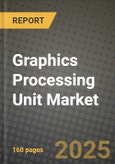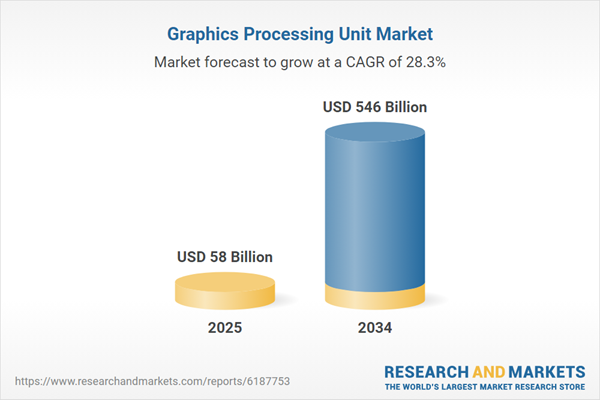Graphics Processing Unit Market Overview
The Graphics Processing Unit (GPU) market is undergoing significant transformation as demand for advanced computing power accelerates across industries. Traditionally designed for rendering graphics in gaming and multimedia applications, GPUs have evolved into essential components for artificial intelligence (AI), machine learning (ML), data analytics, and cloud computing workloads. With industries increasingly relying on real-time data processing and visualizations, GPUs offer the parallel processing capabilities required to handle complex computations. The rise of immersive technologies, such as virtual reality (VR) and augmented reality (AR), further fuels GPU adoption. Additionally, GPU-based computing is becoming central to automotive systems, especially in autonomous vehicles, where real-time decision-making is critical. This market is marked by rapid innovation, competitive dynamics, and growing integration into non-traditional sectors, making GPUs a foundational technology in the digital transformation era.The GPU market experienced notable developments shaped by a convergence of technological innovation and macroeconomic factors. Key manufacturers such as NVIDIA, AMD, and Intel introduced next-generation GPUs boasting enhanced performance, power efficiency, and AI-optimized architectures. The growing sophistication of generative AI models and large language models (LLMs) increased enterprise and cloud provider investments in high-performance GPUs. Gaming also remained a strong contributor, bolstered by new titles and the growing shift toward 4K and ray tracing-enabled graphics. Moreover, geopolitical tensions and chip supply chain challenges led to strategic investments in domestic semiconductor production. Cloud GPU offerings expanded rapidly as providers responded to surging demand from AI developers. These shifts highlighted an industry adapting quickly to technological and structural changes, with product development cycles accelerating to meet new computational requirements.
The GPU market is expected to grow steadily, driven by deeper AI integration, increasing edge computing deployments, and the continued evolution of metaverse platforms. Vendors are anticipated to focus on energy-efficient GPU designs to meet rising concerns about power consumption in data centers. Breakthroughs in quantum computing and neuromorphic architecture may influence GPU design and diversification strategies. Meanwhile, industries like healthcare, finance, and smart manufacturing will broaden their reliance on GPU-powered analytics and real-time visualization tools. Additionally, partnerships between hardware makers and software developers are likely to intensify to unlock maximum GPU performance through tailored software stacks. Regulatory focus on semiconductor supply security will shape long-term investment strategies, pushing countries toward technological self-sufficiency. These trends collectively position GPUs not just as accelerators of computation, but as strategic assets in the future of digital infrastructure.
Key Insights: Graphics Processing Unit Market
- Generative AI and LLMs are significantly influencing GPU design and performance priorities, pushing vendors to develop GPUs capable of efficiently handling massive datasets and accelerating deep learning model training at unprecedented speed and accuracy.
- Cloud GPU adoption is growing as enterprises increasingly opt for GPU-as-a-service models to power AI workloads without capital investment in physical infrastructure, enabling scalability and flexibility across industries.
- Energy-efficient GPUs are gaining momentum, with manufacturers investing in architectures that deliver high performance with reduced power consumption to address sustainability concerns in hyperscale data centers.
- Integration of GPUs in autonomous vehicles and advanced driver-assistance systems (ADAS) is expanding, with high-performance GPUs enabling real-time object detection, path planning, and decision-making in next-generation vehicles.
- AR/VR and metaverse-related developments are driving demand for GPUs capable of delivering ultra-low latency and high-resolution rendering, making immersive experiences smoother and more realistic.
- The exponential rise in artificial intelligence and machine learning applications is boosting GPU demand, as these processors are ideally suited for parallel computation needed in training and inference tasks.
- Gaming industry growth, particularly in 4K, VR, and e-sports, is pushing consumers and developers to seek more powerful GPUs that deliver high frame rates, visual fidelity, and advanced rendering techniques.
- Expansion of data centers and high-performance computing (HPC) applications are driving GPU adoption, as companies require faster data processing for scientific simulations, analytics, and modeling tasks.
- Edge computing growth is encouraging the integration of GPUs in edge devices, enabling real-time data processing and AI inference at the source, reducing latency and enhancing decision-making.
- Supply chain disruptions and geopolitical restrictions continue to challenge GPU availability and cost stability, limiting production scalability and delaying deployment across high-demand sectors such as AI and gaming.
Graphics Processing Unit Market Segmentation
By Component
- Hardware
- Software
- Service
By Deployment Type
- On-Premises
- Cloud
By Industry Vertical
- Electronics
- Information Technology and Telecommunication
- Defense and Intelligence
- Media and Entertainment
- Automotive
- Other Industry Verticals
Key Companies Analysed
- Google LLC
- Samsung Electronics Co.Ltd
- Sony Corporation
- Siemens AG
- Intel Corporation
- IBM Corporation
- Qualcomm Incorporated
- Broadcom Inc.
- Fujitsu Limited
- Toshiba Corporation
- NVIDIA Corporation
- NEC Corporation
- Advanced Micro Devices
- Dassault Systèmes SE
- Marvell Technology Inc.
- Realtek Semiconductor Corp.
- Arm Limited
- Cirrus logic Inc
- Verisilicon Inc
- VIA Technologies Inc.
- ASPEED Technology Inc.
- Matrox Electronic Systems Ltd.
- Imagination Technologies Group
- EVGA Corporation
- Trident Microsystems Inc.
- 3DLabs Inc. Ltd.
- SAPPHIRE Technology Limited
- 3dfx Interactive Inc.
- Rendition Inc.
- Oak Technology Inc.
Graphics Processing Unit Market Analytics
The report employs rigorous tools, including Porter’s Five Forces, value chain mapping, and scenario-based modeling, to assess supply-demand dynamics. Cross-sector influences from parent, derived, and substitute markets are evaluated to identify risks and opportunities. Trade and pricing analytics provide an up-to-date view of international flows, including leading exporters, importers, and regional price trends.Macroeconomic indicators, policy frameworks such as carbon pricing and energy security strategies, and evolving consumer behavior are considered in forecasting scenarios. Recent deal flows, partnerships, and technology innovations are incorporated to assess their impact on future market performance.
Graphics Processing Unit Market Competitive Intelligence
The competitive landscape is mapped through proprietary frameworks, profiling leading companies with details on business models, product portfolios, financial performance, and strategic initiatives. Key developments such as mergers & acquisitions, technology collaborations, investment inflows, and regional expansions are analyzed for their competitive impact. The report also identifies emerging players and innovative startups contributing to market disruption.Regional insights highlight the most promising investment destinations, regulatory landscapes, and evolving partnerships across energy and industrial corridors.
Countries Covered
- North America - Graphics Processing Unit market data and outlook to 2034
- United States
- Canada
- Mexico
- Europe - Graphics Processing Unit market data and outlook to 2034
- Germany
- United Kingdom
- France
- Italy
- Spain
- BeNeLux
- Russia
- Sweden
- Asia-Pacific - Graphics Processing Unit market data and outlook to 2034
- China
- Japan
- India
- South Korea
- Australia
- Indonesia
- Malaysia
- Vietnam
- Middle East and Africa - Graphics Processing Unit market data and outlook to 2034
- Saudi Arabia
- South Africa
- Iran
- UAE
- Egypt
- South and Central America - Graphics Processing Unit market data and outlook to 2034
- Brazil
- Argentina
- Chile
- Peru
Research Methodology
This study combines primary inputs from industry experts across the Graphics Processing Unit value chain with secondary data from associations, government publications, trade databases, and company disclosures. Proprietary modeling techniques, including data triangulation, statistical correlation, and scenario planning, are applied to deliver reliable market sizing and forecasting.Key Questions Addressed
- What is the current and forecast market size of the Graphics Processing Unit industry at global, regional, and country levels?
- Which types, applications, and technologies present the highest growth potential?
- How are supply chains adapting to geopolitical and economic shocks?
- What role do policy frameworks, trade flows, and sustainability targets play in shaping demand?
- Who are the leading players, and how are their strategies evolving in the face of global uncertainty?
- Which regional “hotspots” and customer segments will outpace the market, and what go-to-market and partnership models best support entry and expansion?
- Where are the most investable opportunities - across technology roadmaps, sustainability-linked innovation, and M&A - and what is the best segment to invest over the next 3-5 years?
Your Key Takeaways from the Graphics Processing Unit Market Report
- Global Graphics Processing Unit market size and growth projections (CAGR), 2024-2034
- Impact of Russia-Ukraine, Israel-Palestine, and Hamas conflicts on Graphics Processing Unit trade, costs, and supply chains
- Graphics Processing Unit market size, share, and outlook across 5 regions and 27 countries, 2023-2034
- Graphics Processing Unit market size, CAGR, and market share of key products, applications, and end-user verticals, 2023-2034
- Short- and long-term Graphics Processing Unit market trends, drivers, restraints, and opportunities
- Porter’s Five Forces analysis, technological developments, and Graphics Processing Unit supply chain analysis
- Graphics Processing Unit trade analysis, Graphics Processing Unit market price analysis, and Graphics Processing Unit supply/demand dynamics
- Profiles of 5 leading companies - overview, key strategies, financials, and products
- Latest Graphics Processing Unit market news and developments
Additional Support
With the purchase of this report, you will receive:- An updated PDF report and an MS Excel data workbook containing all market tables and figures for easy analysis.
- 7-day post-sale analyst support for clarifications and in-scope supplementary data, ensuring the deliverable aligns precisely with your requirements.
- Complimentary report update to incorporate the latest available data and the impact of recent market developments.
This product will be delivered within 1-3 business days.
Table of Contents
Companies Mentioned
- Google LLC
- Samsung Electronics Co.Ltd.
- Sony Corporation
- Siemens AG
- Intel Corporation
- IBM Corporation
- Qualcomm Incorporated
- Broadcom Inc.
- Fujitsu Limited
- Toshiba Corporation
- NVIDIA Corporation
- NEC Corporation
- Advanced Micro Devices
- Dassault Systèmes SE
- Marvell Technology Inc.
- Realtek Semiconductor Corp.
- Arm Limited
- Cirrus logic Inc.
- Verisilicon Inc.
- VIA Technologies Inc.
- ASPEED Technology Inc.
- Matrox Electronic Systems Ltd.
- Imagination Technologies Group
- EVGA Corporation
- Trident Microsystems Inc.
- 3DLabs Inc. Ltd.
- SAPPHIRE Technology Limited
- 3dfx Interactive Inc.
- Rendition Inc.
- Oak Technology Inc.
Table Information
| Report Attribute | Details |
|---|---|
| No. of Pages | 160 |
| Published | October 2025 |
| Forecast Period | 2025 - 2034 |
| Estimated Market Value ( USD | $ 58 Billion |
| Forecasted Market Value ( USD | $ 546 Billion |
| Compound Annual Growth Rate | 28.2% |
| Regions Covered | Global |
| No. of Companies Mentioned | 30 |









